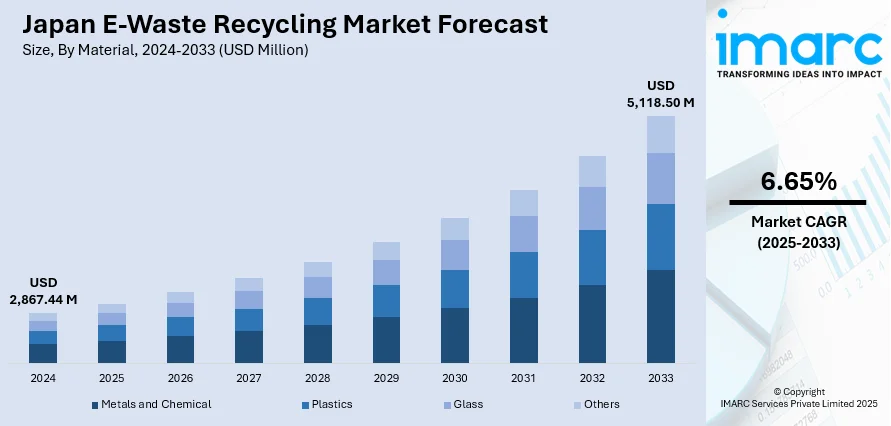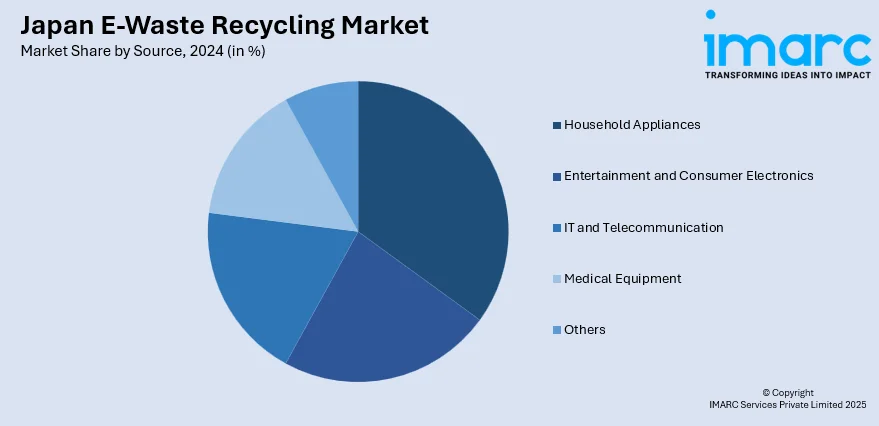
Japan E-Waste Recycling Market Size, Share, Trends and Forecast by Material, Source, and Region, 2025-2033
Japan E-Waste Recycling Market Overview:
The Japan e-waste recycling market size reached USD 2,867.44 Million in 2024. Looking forward, IMARC Group expects the market to reach USD 5,118.50 Million by 2033, exhibiting a growth rate (CAGR) of 6.65% during 2025-2033. The market is driven by strict environmental regulations, advanced recycling technologies, and strong public awareness. The country emphasizes responsible disposal and resource recovery, supported by government and industry initiatives. Continuous innovation and collaboration enhance efficiency in processing discarded electronics, contributing to sustainability goals. These factors collectively influence the dynamics of the Japan e-waste recycling market share.
|
Report Attribute
|
Key Statistics
|
|---|---|
|
Base Year
|
2024
|
|
Forecast Years
|
2025-2033
|
|
Historical Years
|
2019-2024
|
| Market Size in 2024 | USD 2,867.44 Million |
| Market Forecast in 2033 | USD 5,118.50 Million |
| Market Growth Rate 2025-2033 | 6.65% |
Japan E-Waste Recycling Market Trends:
Advanced Recycling Technologies and Infrastructure
Japan is a global leader in recycling technologies, which enables efficient and safe processing of electronic waste. The country uses modern equipment to separate, sort, and recover gold, silver, and rare earth elements from old electronic devices. Many businesses rely on AI and automation to ensure accuracy and cut back on risks for workers. Japan’s commitment to good recycling plants means there is little impact on the environment during recycling. Improved technology ensures that more useful materials are recovered and that strategic components can be used again in the circular economy. The strong infrastructure allows the recycling industry to grow and is very important to the market in Japan.

To get more information on this market, Request Sample
Growing Environmental Awareness Among Consumers
Japanese society places a high value on environmental responsibility, and public awareness campaigns have further educated consumers about the importance of recycling e-waste. Schools, communities, and government initiatives emphasize sustainable practices, leading to widespread participation in recycling programs. Citizens are increasingly informed about the environmental and health risks associated with improper disposal of electronics, such as the release of toxic substances into the soil and water. As a result, there is a strong cultural norm around separating and returning e-waste through designated channels. This heightened awareness directly contributes to higher collection rates and supports a more effective recycling system. Consumer engagement is essential for driving demand for responsible recycling services, making public consciousness a major factor in the Japan e-waste recycling market growth.
Rapid Technological Advancement and Product Obsolescence
Japan’s tech-driven economy produces a constant flow of new electronic products, including smartphones, computers, appliances, and entertainment systems. As newer models are introduced with better features and improved performance, older devices become obsolete more quickly. This cycle of innovation and replacement contributes to a significant increase in electronic waste generation. Additionally, planned obsolescence by manufacturers and changing consumer preferences further shorten the lifespan of electronic goods. The growing volume of discarded electronics presents both a challenge and an opportunity for the recycling market. It ensures a steady supply of e-waste for processing while highlighting the need for efficient and scalable recycling solutions. This constant turnover in electronics consumption is a powerful force driving the demand for advanced e-waste recycling systems across Japan.
Japan E-Waste Recycling Market Segmentation:
IMARC Group provides an analysis of the key trends in each segment of the market, along with forecasts at the country and regional levels for 2025-2033. Our report has categorized the market based on material and source.
Material Insights:
- Metals and Chemical
- Plastics
- Glass
- Others
The report has provided a detailed breakup and analysis of the market based on the material. This includes metals and chemical, plastics, glass, and others.
Source Insights:

- Household Appliances
- Entertainment and Consumer Electronics
- IT and Telecommunication
- Medical Equipment
- Others
A detailed breakup and analysis of the market based on the source have also been provided in the report. This includes household appliances, entertainment and consumer electronics, IT and telecommunication, medical equipment, and others.
Regional Insights:
- Kanto Region
- Kansai/Kinki Region
- Central/ Chubu Region
- Kyushu-Okinawa Region
- Tohoku Region
- Chugoku Region
- Hokkaido Region
- Shikoku Region
The report has also provided a comprehensive analysis of all the major regional markets, which include the Kanto Region, Kansai/Kinki Region, Central/ Chubu Region, Kyushu-Okinawa Region, Tohoku Region, Chugoku Region, Hokkaido Region, and Shikoku Region.
Competitive Landscape:
The market research report has also provided a comprehensive analysis of the competitive landscape. Competitive analysis such as market structure, key player positioning, top winning strategies, competitive dashboard, and company evaluation quadrant has been covered in the report. Also, detailed profiles of all major companies have been provided.
Japan E-Waste Recycling Market News:
- In February 2023, with its headquarters located in Minato-ku, Tokyo, The ITOCHU Corporation, and its president and chief executive officer, Keita Ishii, announced that it is launching the e-waste compensation program for corporate users in collaboration with Closing the Loop, which is based in Amsterdam, the Netherlands, and whose president and chief executive officer is Joost de Kluijver. Closing the Loop collects and recycles electronic waste, or "e-waste," including mobile phones, in Africa. Every time a new mobile device is sold in Japan, the initiative recycles one in Africa.
Japan E-Waste Recycling Market Report Coverage:
| Report Features | Details |
|---|---|
| Base Year of the Analysis | 2024 |
| Historical Period | 2019-2024 |
| Forecast Period | 2025-2033 |
| Units | Million USD |
| Scope of the Report |
Exploration of Historical Trends and Market Outlook, Industry Catalysts and Challenges, Segment-Wise Historical and Future Market Assessment:
|
| Materials Covered | Metals and Chemical, Plastics, Glass, Others |
| Sources Covered | Household Appliances, Entertainment And Consumer Electronics, IT And Telecommunication, Medical Equipment, Others |
| Regions Covered | Kanto Region, Kansai/Kinki Region, Central/ Chubu Region, Kyushu-Okinawa Region, Tohoku Region, Chugoku Region, Hokkaido Region, Shikoku Region |
| Customization Scope | 10% Free Customization |
| Post-Sale Analyst Support | 10-12 Weeks |
| Delivery Format | PDF and Excel through Email (We can also provide the editable version of the report in PPT/Word format on special request) |
Key Questions Answered in This Report:
- How has the Japan e-waste recycling market performed so far and how will it perform in the coming years?
- What is the breakup of the Japan e-waste recycling market on the basis of material?
- What is the breakup of the Japan e-waste recycling market on the basis of source?
- What is the breakup of the Japan e-waste recycling market on the basis of region?
- What are the various stages in the value chain of the Japan e-waste recycling market?
- What are the key driving factors and challenges in the Japan e-waste recycling market?
- What is the structure of the Japan e-waste recycling market and who are the key players?
- What is the degree of competition in the Japan e-waste recycling market?
Key Benefits for Stakeholders:
- IMARC’s industry report offers a comprehensive quantitative analysis of various market segments, historical and current market trends, market forecasts, and dynamics of the Japan e-waste recycling market from 2019-2033.
- The research report provides the latest information on the market drivers, challenges, and opportunities in the Japan e-waste recycling market.
- Porter's five forces analysis assist stakeholders in assessing the impact of new entrants, competitive rivalry, supplier power, buyer power, and the threat of substitution. It helps stakeholders to analyze the level of competition within the Japan e-waste recycling industry and its attractiveness.
- Competitive landscape allows stakeholders to understand their competitive environment and provides an insight into the current positions of key players in the market.
Need more help?
- Speak to our experienced analysts for insights on the current market scenarios.
- Include additional segments and countries to customize the report as per your requirement.
- Gain an unparalleled competitive advantage in your domain by understanding how to utilize the report and positively impacting your operations and revenue.
- For further assistance, please connect with our analysts.
 Request Customization
Request Customization
 Speak to an Analyst
Speak to an Analyst
 Request Brochure
Request Brochure
 Inquire Before Buying
Inquire Before Buying




.webp)




.webp)












